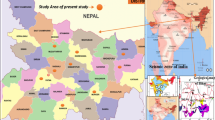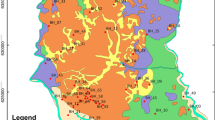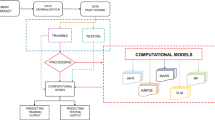Abstract
Liquefaction is one of the most disastrous phenomena that arises due to earthquakes and has always been a major concern for engineers due to the damages and devastation it causes to the environment, structures and the human life. Liquefaction evaluation has been studied vigorously by many researchers for past few decades and based on their observations various researchers gave different limits of PI and other geotechnical parameters which classified soil in liquefiable, potentially liquefiable and non-liquefiable zones, but the question of reliability still needs to be addressed. The present study provides a new set of range for plasticity index and wc/LL ratio for liquefaction classification of fine-grained soil. The present study develops a computational model based on in situ soil properties to evaluate liquefaction potential. Artificial neural network (ANN) model has been developed for predicting liquefaction susceptibility. The significance of plasticity index on liquefaction has been primarily considered while developing the ANN model. The results confirm that the use of artificial intelligence shows the best success rate amongst all the considered approaches for prediction of liquefaction. Due to its efficient cost and quick predictions, it can be used as a sustainable method for evaluating and predicting risk against seismic hazard and infrastructural development.











Similar content being viewed by others
References
Andrews DCA, Martin GR (2000) Criteria for liquefaction of silty soils. In: Proceedings of 12th World Conference on Earthquake Engineering, Auckland, New Zealand
Boulanger RW, Idriss IM (2006) Liquefaction susceptibility criteria for silts and clays. J Geotech Geoenviron Eng 132(11):1413–1426
Boulanger RW, Mejia LH, Idriss IM (1997) Liquefaction at Moss Landing during Loma Prieta earthquake. ASCE J Geotech Geoenviron Eng 123:453–467
Bray JD, Sancio RB (2006) Assessment of the Liquefaction Susceptibility of Fine Grained Soil”. J Geotech Eng 132(9):1165–1177
Chu BL, Hsu SC, Chang YM (2004) Ground behavior and liquefaction analyses in central Taiwan-Wufeng. Eng Geol 71:119–139
Farrokhzad F, Choobbasti AJ, Barari A (2010) Artificial neural network model for prediction of liquefaction potential in soil deposits. In: International Conferences on Recent Advances in Geotechnical Earthquake Engineering and Soil Dynamics, p 4
Ghani S, Kumari S (2020) Insight into the effect of fine content on liquefaction behavior of soil. Geotech Geol Eng. https://doi.org/10.1007/s10706-020-01491-3
Ghanizadeh AR, Heidarabadizadeh N, Jalali F (2020) Artificial neural network back-calculation of flexible pavements with sensitivity analysis using Garson’s and connection weights algorithms. Innov Infrastruct Solut 5:63. https://doi.org/10.1007/s41062-020-00312
Gratchev I, Sassa K, Fukuoka H (2006) How reliable is the plasticity index for estimating the liquefaction potential of clayey sands? J Geotech Geoenviron Eng 132(1):124–127
Holzer TL, Bennett MJ, Ponti DJ, Tinsley CIII (1999) Liquefaction and soil failure during 1994 Northbridge earthquake. J Geotech Geoenviron Eng ASCE 125:438–452
Idriss IM, Boulanger R (2006) Semi-empirical procedures for evaluating liquefaction potential during earthquakes. J Soil Dyn Earthquake Eng 26(2):115–130
Bray JD, Sancio RB, Riemer M, Durgunoglu HT (2004) Liquefaction susceptibility of fine-grained soils. In: International Conference on Geotechnical Earthquake Engineering
Choobbasti J, Selatahneh A, Petanlar H, Karimi M (2020) Effect of fines on liquefaction resistance of sand. Innov Infrastruct Solut 5:87. https://doi.org/10.1007/s41062-020-00338-3
Lee DH, Ku CS, Yuan H (2004) A study of the liquefaction risk potential at Yuanlin, Taiwan. Eng Geol 71:97–117
Marto A, Tan CS, Makhtar AM, Ung SW, Lim MY (2015) Effect of plasticity on liquefaction susceptibility of sand-fines mixtures. Appl Mech Mater 773–774:1407–1411
Miura S, Kawamura S, Yagi K (1995) Liquefaction damage of sandy and volcanic grounds in the 1993 Hokkaido Nansei-Oki earthquake. In: Prakash S (ed) Proceedings of the 3rd international conference on recent advances in geotechnical earthquake engineering and soil dynamics, St Louis, MO, vol 1. University of Missouri-Rolla, Rolla, pp 193–196
More JJ (1977) The levenberg-marquardt algorithm: implementation and theory. Springer, Heidelberg, pp 105–116
Samui P, Sitharam TG (2011) Machine learning modelling for predicting soil liquefaction susceptibility. Nat Hazards Earth Syst Sci 11:1–9
Paydar NA, Ahmadi MM (2016) Effect of fines type and content of sand on Correlation between shear wave velocity and liquefaction resistance. Geotech Geol Eng 34(6):1857–1876
Polito C, (2001) Plasticity based liquefaction criteria. In: Proceedings of the 4th international Conference on recent advances in Geotechnical earthquake engineering and soil dynamics
Seed HB (1979) Soil liquefaction and cyclic mobility evaluation for level ground during earthquakes. J Geotech Eng Div 105(2):201–255
Seed HB, Idriss IM (1971) Simplified procedure for evaluating soil liquefaction potential. J Soil Mech Found Div 97:1249–1274
Seed HB, Idriss IM (1982) Ground motions and soil liquefaction during earthquakes. Earthquake Engineering Research Institute, Berkeley
Seed HB, Idriss IM, Arango I (1983) Evaluation of liquefaction potential using field performance. J Geotech Eng 109(3):458–482
Seed H Bolton, Lee KL (1966) Liquefaction of saturated sands during cyclic loading. J Soil Mech Founclat Div ASCE 92(SM6):105–134
Seed RB, Cetin KO, Moss RES, Kammerer AM, Wu J, Pestana JM, Riemer MF, Sancio RB, Bray JD, Kayen RE, Faris A (2003) Recent advances in soil liquefaction engineering: a unified and consistent framework EERC-2003–06. Earthquake Engineering Research Institute, Berkeley
Shreyas SK, Dey A (2019) Application of soft computing techniques in tunnelling and underground excavations: state of the art and future prospects. Innov Infrastruct Solut 4:46. https://doi.org/10.1007/s41062-019-0234
Shukla D, Solanki CH (2020) Estimated empirical correlations between shear wave velocity and SPT-N value for indore City using NLR and ANN. Indian Geotech J. https://doi.org/10.1007/s40098-020-00417-3
Vijay K, Kumar V, Tiwari RP, Yeetendra K (2012) Application of ANN to predict liquefaction potential. Int J Comput Eng Res, ISSN: 2250–3005
Wang W (1979) Some findings in soil liquefaction. Report Water Conservancy and Hydro-electric Power Scientific Research Institute, Beijing, pp 1–17
Yaun H, Yang SH, Andrus RD, Junag CH (2004) Liquefaction-induced ground failure: a study of the Chi- Chi earthquake cases. Eng Geol 71:141–155
Ebdali M, Khorasani E, Salehin S (2020) A comparative study of various hybrid neural networks and regression analysis to predict unconfined compressive strength of travertine. Innov Infrastruct Solut 5:93. https://doi.org/10.1007/s41062-020-00346-3
Abbaszadeh Shahri A, Asheghi R (2018) Optimized developed artificial neural network-based models to predict the blast-induced ground vibration. Innov Infrastruct Solut 3:34. https://doi.org/10.1007/s41062-018-0137-4
Bourouis M, Zadjaoui A, Djedid A (2020) Contribution of two artificial intelligence techniques in predicting the secondary compression index of fine-grained soils. Innov Infrastruct Solut 5:96. https://doi.org/10.1007/s41062-020-00348-1
Mughieda O, Bani-Hani K, Safieh B (2009) Liquefaction assessment by artificial neural networks based on CPT. Int J Geotech Eng 3(2):289–302. https://doi.org/10.3328/IJGE.2009.03.02.289-302
Sabbar AS, Chegenizadeh A, Nikraz H (2019) Prediction of liquefaction susceptibility of clean sandy soils using artificial intelligence techniques. Indian Geotech J 49:58–69. https://doi.org/10.1007/s40098-017-0288-9
Young-Su K, Byung-Tak K (2006) Use of artificial neural networks in the prediction of liquefaction resistance of sands. J Geotech Geoenviron Eng 132(11):1502–1504. https://doi.org/10.1061/(ASCE)1090-0241(2006)132:11(1502)
Author information
Authors and Affiliations
Corresponding author
Ethics declarations
Conflict of interest
On behalf of all authors, the corresponding author states that there is no conflict of interest.
Appendix
Appendix
See Table 7.
Rights and permissions
About this article
Cite this article
Ghani, S., Kumari, S. Liquefaction study of fine-grained soil using computational model. Innov. Infrastruct. Solut. 6, 58 (2021). https://doi.org/10.1007/s41062-020-00426-4
Received:
Accepted:
Published:
DOI: https://doi.org/10.1007/s41062-020-00426-4




